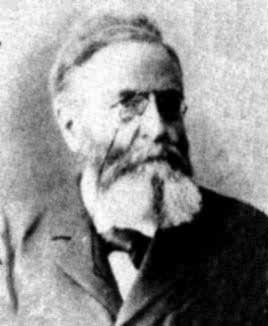
Heinrich Martin Weber
 المؤلف:
B Schoeneberg
المؤلف:
B Schoeneberg
 المصدر:
Biography in Dictionary of Scientific Biography
المصدر:
Biography in Dictionary of Scientific Biography
 الجزء والصفحة:
...
الجزء والصفحة:
...
 26-1-2017
26-1-2017
 869
869
Born: 5 May 1842 in Heidelberg, Germany
Died: 17 May 1913 in Strasbourg, Germany (now France)

Heinrich Weber was born in Heidelberg, the son of G Weber who was an historian. He entered the University of Heidelberg in 1860 but, as was the common practice of German students at this time, he spent part of his time studying at a different university. For Weber it was the University of Leipzig that he moved to in the middle of his studies, spending a year there before returning to Heidelberg to complete his education. He was awarded a doctorate from the University of Heidelberg in 1863.
In order to become a university teacher, Weber needed to write a further thesis, his habilitation thesis. He went to Königsberg where he studied under Franz Neumann and Friedrich Richelot, who had been a student of Jacobi. Although Jacobi had died over ten years before Weber began his studies at Königsberg, his influence was still strongly felt and it would not be unreasonable to say that Weber, through his teachers at Königsberg, was strongly influenced by Jacobi's style of mathematics. There were other students at Königsberg at this time who would become important in the development of mathematics, in particular Wangerin studied for his doctorate around the same time as Weber worked for his habilitation.
In 1866 Weber's habilitation thesis was accepted and he became a privatdozent at Heidelberg in that year. Three years later he was appointed as extraordinary professor at Heidelberg. Over the next twenty-five years, Weber taught at a number of different institutions. He taught in Zurich at the Eidgenössische Polytechnikum, at the University of Königsberg, and at the Technische Hochschule in Charlottenburg. His final post was in Strasbourg where he was appointed in 1895.
The city of Strasbourg was German at this time (and called Strassburg) and it had been since it was annexed by Germany during the Franco-Prussian War of 1870-71. Weber remained in Strasbourg for the rest of his life and during this time it remained a German city; only at the end of the World War I in 1918 did the city revert to France
Weber's main work was in algebra, number theory, analysis and applications of analysis to mathematical physics. This seems a contradiction in terms, for we have now almost said that Weber's main work spans the whole spectrum of mathematics. In fact this is not far from the truth for Weber work was characterised by its breadth across a wide range of topics.
To a certain extent this breadth can be attributed to the various influences on Weber from colleagues around him. The applications to mathematical physics certainly grew from working with Franz Neumann in Königsberg. But in Königsberg there was also the Jacobi influence, particularly coming through one of his other teacher Friedrich Richelot, which saw Weber doing important work on algebraic functions.
Perhaps Weber is best known for his outstanding text Lehrbuch der Algebra published in 1895 and it is his work in algebra and number theory for which he is best known. If he was influenced by his colleagues to work in different areas of mathematics then it is a very fair question to ask where the influence came from which prompted Weber to work on algebra and number theory. The answer must be Dedekind. He wrote an important paper with Dedekind in 1882 in which they examined algebraic functions from an algebraic rather than analytic point of view.
Weber's Lehrbuch der Algebra is an outstanding work but, although he tried hard to connect the various algebraic theories, even fundamental concepts such as a field and a group are only seen as tools and not properly developed as theories in their own right. It was, however, a remarkable book which was effective over many years as a teaching tool. In fact [1]:-
Weber was an enthusiastic and inspiring teacher who took great interest in educational questions.
- B Schoeneberg, Biography in Dictionary of Scientific Biography (New York 1970-1990).
http://www.encyclopedia.com/doc/1G2-2830904577.html
Books:
- Festschrift Heinrich Weber zu seinem siebzigsten Geburtstag am 5. März 1912 (New York, 1971).
Articles:
- G Frei, Heinrich Weber and the emergence of class field theory, The history of modern mathematics I (Boston, MA, 1989), 425-450.
- A Voss, Heinrich Weber, Jahresberichte der Deutschen Mathematiker-Vereinigung 23 (1914), 431-444.
 الاكثر قراءة في 1840to1849
الاكثر قراءة في 1840to1849
 اخر الاخبار
اخر الاخبار
اخبار العتبة العباسية المقدسة


